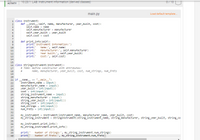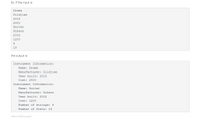
Database System Concepts
7th Edition
ISBN: 9780078022159
Author: Abraham Silberschatz Professor, Henry F. Korth, S. Sudarshan
Publisher: McGraw-Hill Education
expand_more
expand_more
format_list_bulleted
Question
10.23 LAB: Instrument information (derived classes)
Given the base class Instrument, define a derived class StringInstrument for string instruments.
Use Python for this.

Transcribed Image Text:10.23.1: LAB: Instrument information (derived classes)
0/ 10
АCTIVITY
main.py
Load default template.
1 class Instrument:
def _init_(self, name, manufacturer, year_built, cost):
self.name = name
self.manufacturer = manufacturer
2
3
4
self.year_built = year_built
self.cost = cost
7
def print_info(self):
print('Instrument Information:')
print('
print(' Manufacturer:', self.manufacturer)
print('
print('
8
10
Name:', self.name)
11
Year built:', self.year_built)
Cost:', self.cost)
12
13
14
15
16 class StringInstrument(Instrument):
17
# TODO: Define constructor with attributes:
name, manufacturer, year_built, cost, num_strings, num frets
18
23
19
20
21 if
-_name_==
instrument_name - input()
manufacturer_name = input ()
year_built = int(input())
cost - int(input ())
string_instrument_name = input()
string_manufacturer = input()
string_year_built = int(input())
string cost = int(input())"
num_strings = int(input())
num_frets = int(input())
_main_":
22
23
24
25
26
27
28
29
зе
31
32
my_instrument = Instrument(instrument_name, manufacturer_name, year_built, cost)
my_string_instrument = stringInstrument(string_instrument_name, string_manufacturer, string_year_built, string_co
33
34
35
my_instrument.print_info()
my_string_instrument.print_info()
36
37
38
print('
print(
Number of strings:', my_string_instrument.num_strings)
Number of frets:', my_string_instrument.num_frets)
39
40

Transcribed Image Text:Ex: If the input is:
Drums
Zildjian
2015
2500
Guitar
Gibson
2002
1200
19
the output is:
Instrument Information:
Name: Drums
Manufacturer: Zildjian
Year built: 2015
Cost: 2500
Instrument Information:
Name: Guitar
Manufacturer: Gibson
Year built: 2002
Cost: 1200
Number of strings: 6
Number of frets: 19
3446142153518.qxazay7
Expert Solution
This question has been solved!
Explore an expertly crafted, step-by-step solution for a thorough understanding of key concepts.
This is a popular solution
Trending nowThis is a popular solution!
Step by stepSolved in 10 steps with 9 images

Knowledge Booster
Learn more about
Need a deep-dive on the concept behind this application? Look no further. Learn more about this topic, computer-science and related others by exploring similar questions and additional content below.Similar questions
- 3. (10) Given below is the CRC diagram for a Circle ADT. Give the class definition and function definitions for this ADT. Circle - int r // radius // Constructors + Circle( int ) // Mutator + void setR( int) II Accessors + int getR( ) + int area( )arrow_forwarda. Write a class BumbleBee that inherits from Insect. Add the public member function void sting() const . This function simply prints "sting!" and a newline. b. Write a class GrassHopper that inherits from Insect. Add the public member function void hop() const . This function simply prints "hop!" and a newline. When you are done your program output should look exactly like the output provided at the end of the file. Do not modify the main program. Do not modify the Insect class.arrow_forwardMay I please have your assistance with this lab: 2.15 LAB: Artwork label ( modules) Part of the code is correct. I am only needing the code to be correct for the following errors: This is the current code & errors at bottom of code: # Artist.py class Artist: # below is the comstructor to initializez artist infomration # constructor initialize the artist's name to "None" and the years of birth and death to 0 def __init__(self, name='None', birth_year=0, death_year=0): self.name = name self.birth_year = birth_year self.death_year = death_year def print_info(self): if self.birth_year >= 0 and self.death_year >= 0: print(f'Artist: {self.name} ({self.birth_year} to {self.death_year})') elif self.birth_year >= 0: print(f'Artist: {self.name} ({self.birth_year} - present)') else: print(f'Artist: {self.name} (unkown)') # Artwork.py class Artwork:…arrow_forward
- Question 5 (6 marks) Given the following interface class interface Bigoperation { public Biglnteger operation (Biglnteger x, Biglnteger y); Write Lambda expressions to implement BigOperation to simulate three arithmetic operations *, / and % on Biglnteger. You can call them op1, op2 and op3 respectively. Note that the three operations in Biglnteger are called multiply, divide and remainder respectively. Using these three operations, we wish to multiply all the digits in a Biglnteger. For example, if the Biginteger is 234, the product is 2* 3*4 = 24. The method has the following method heading: static BigInteger product (Biglnteger n, BigOperation op1, BigOperation op2, BigOperation op3) Compare the implementation of this method using two approaches: Iterative and Recursive. Put the Lambda expressions in a main method. Construct a few Biglnteger objects, invoke the methods to test our design. The following shows some of the sample outputs:arrow_forward3- Write a program to implement a class "student" with the following members. Name of the student. Marks of the student obtained in three subjects. Function to assign initial values. Function to compute total average. Function to display the student's name and the total marks. Write an appropriate main() function to demonstrate the functioning of the above.arrow_forwardR7.30Assuming the following declarations, find the mistakes in the statements below. struct A { int m1[2]; int m2; } struct B { A a1; A* a2; int m3; } A a; B b[2]; a.b[0].a2 = a; b.b[1].m2 = 42; c.b[2].a2 = new A; d.b[0].a1.m1 = 42; e.b[1].a2->m2 = 42;arrow_forward
arrow_back_ios
arrow_forward_ios
Recommended textbooks for you
 Database System ConceptsComputer ScienceISBN:9780078022159Author:Abraham Silberschatz Professor, Henry F. Korth, S. SudarshanPublisher:McGraw-Hill Education
Database System ConceptsComputer ScienceISBN:9780078022159Author:Abraham Silberschatz Professor, Henry F. Korth, S. SudarshanPublisher:McGraw-Hill Education Starting Out with Python (4th Edition)Computer ScienceISBN:9780134444321Author:Tony GaddisPublisher:PEARSON
Starting Out with Python (4th Edition)Computer ScienceISBN:9780134444321Author:Tony GaddisPublisher:PEARSON Digital Fundamentals (11th Edition)Computer ScienceISBN:9780132737968Author:Thomas L. FloydPublisher:PEARSON
Digital Fundamentals (11th Edition)Computer ScienceISBN:9780132737968Author:Thomas L. FloydPublisher:PEARSON C How to Program (8th Edition)Computer ScienceISBN:9780133976892Author:Paul J. Deitel, Harvey DeitelPublisher:PEARSON
C How to Program (8th Edition)Computer ScienceISBN:9780133976892Author:Paul J. Deitel, Harvey DeitelPublisher:PEARSON Database Systems: Design, Implementation, & Manag...Computer ScienceISBN:9781337627900Author:Carlos Coronel, Steven MorrisPublisher:Cengage Learning
Database Systems: Design, Implementation, & Manag...Computer ScienceISBN:9781337627900Author:Carlos Coronel, Steven MorrisPublisher:Cengage Learning Programmable Logic ControllersComputer ScienceISBN:9780073373843Author:Frank D. PetruzellaPublisher:McGraw-Hill Education
Programmable Logic ControllersComputer ScienceISBN:9780073373843Author:Frank D. PetruzellaPublisher:McGraw-Hill Education

Database System Concepts
Computer Science
ISBN:9780078022159
Author:Abraham Silberschatz Professor, Henry F. Korth, S. Sudarshan
Publisher:McGraw-Hill Education

Starting Out with Python (4th Edition)
Computer Science
ISBN:9780134444321
Author:Tony Gaddis
Publisher:PEARSON

Digital Fundamentals (11th Edition)
Computer Science
ISBN:9780132737968
Author:Thomas L. Floyd
Publisher:PEARSON

C How to Program (8th Edition)
Computer Science
ISBN:9780133976892
Author:Paul J. Deitel, Harvey Deitel
Publisher:PEARSON

Database Systems: Design, Implementation, & Manag...
Computer Science
ISBN:9781337627900
Author:Carlos Coronel, Steven Morris
Publisher:Cengage Learning

Programmable Logic Controllers
Computer Science
ISBN:9780073373843
Author:Frank D. Petruzella
Publisher:McGraw-Hill Education